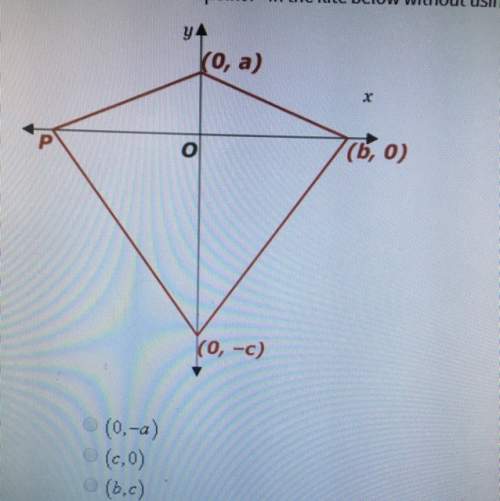
Mathematics, 11.01.2021 04:50 ab847150
Given AC with A(3, 4) and C(-9, -2), if B partitions AC such that the ratio of AB to BC is 1:5, find the coordinates of B

Answers: 1
Another question on Mathematics

Mathematics, 21.06.2019 13:00
#12 find the value of x. #13 find the value of the variable.
Answers: 3

Mathematics, 21.06.2019 15:30
Which of the following statements is not true? a.parallel lines are lines in the same plane that never intersect. b.congruent figures have the same shape and same size angles and sides. c.similar figures must have the same shape and the same size. d.a rotation is when you turn a figure around a certain point.
Answers: 1

Mathematics, 21.06.2019 16:00
Answer asap ! the shortest path from point a to point b goes through a pond. to avoid the pond, you must walk straight 34 meters along one edge of the pond, then take a 90 degree turn, and again walk straight 41 meters along another edge of the pond to reach point b. about how many meters would be saved if it were possible to walk through the pond? a. 11 m b. 20 m c. 30.45 m d. 21.73 m
Answers: 1

Mathematics, 21.06.2019 17:00
In tossing one coin 10 times, what are your chances for tossing a head? a tail? 2. in tossing one coin 100 times, what are your chances for tossing a head? a tail? 3. in tossing one coin 200 times, what are your chances for tossing a head? a tail? deviation = ((absolute value of the difference between expected heads and observed heads) + (absolute value of the difference between expected tails and observed tails)) divided by total number of tosses. this value should always be positive. 4. what is the deviation for 10 tosses? 5. what is the deviation for the 100 tosses? 6. what is the deviation for 200 tosses? 7. how does increasing the total number of coin tosses from 10 to 100 affect the deviation? 8. how does increasing the total number of tosses from 100 to 200 affect the deviation? 9. what two important probability principles were established in this exercise? 10. the percent of occurrence is the obtained results divided by the total tosses and multiplied by 100%. toss the coins 100 times and record your results. calculate the percent occurrence for each combination. percent head-head occurrence: percent tail-tail occurrence: percent head-tail occurrence:
Answers: 3
You know the right answer?
Given AC with A(3, 4) and C(-9, -2), if B partitions AC such that the ratio of AB to BC is 1:5, find...
Questions


Mathematics, 09.11.2020 05:50

Chemistry, 09.11.2020 05:50

Mathematics, 09.11.2020 05:50


Mathematics, 09.11.2020 05:50

Mathematics, 09.11.2020 05:50






Mathematics, 09.11.2020 05:50

Mathematics, 09.11.2020 05:50

Mathematics, 09.11.2020 05:50

Spanish, 09.11.2020 05:50

Computers and Technology, 09.11.2020 05:50

Mathematics, 09.11.2020 05:50

Computers and Technology, 09.11.2020 05:50




